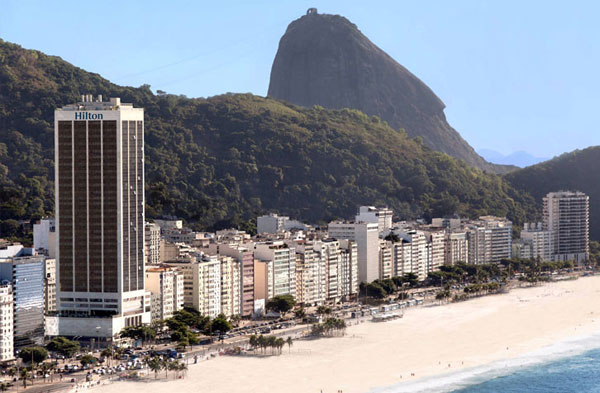✕

Column: industry Tag: Hilton,select-service brands,Latin America Published: 2017-10-27 13:27 Source: Author:

Hilton’s 100th opening in Latin America happened in May with the opening of the Hilton Rio de Janeiro Copacabana. (Photo: Hilton)
BUENOS AIRES, Argentina—Latin America continues to be a priority for Hilton’s expansion, and according to development executives select-service brands drive the company’s pipeline, largely fueled by demand from a growing middle class of travelers in the region.
“It’s a recurring theme that the middle class is growing and continues to grow (in Latin America),” said Ted Middleton, SVP of development in Latin America for Hilton, during a break at the South America Hotel Investment Conference in September. “All the major hotel chains have expanded footprints down here, but as the supply of hotels increases, there hasn’t been a significant decrease in occupancy.”
Middleton said “the sky’s the limit” for Hilton development across Latin America. As of the end of the second quarter, the company had achieved the opening of its 100th hotel in the region, bringing room count up to 17,500 rooms. Of the more than 70 hotels and 11,300 guestrooms in the company’s Latin America pipeline, 60% are in select-service brands, including Hilton Garden Inn and Hampton by Hilton.
“I think these are going to be the brands that will continue to lead development,” Middleton said. “Hampton because it’s our least expensive product and there’s a strong market for it, and Hilton Garden Inns are great in secondary or tertiary markets, where they’re the ‘Hilton’ of the city.”
Regional financing trends
Both Middleton and Juan Corvinos, Hilton’s VP of development for Mexico, Central America, the Andean region and the Hispanic Caribbean, emphasized that the Latin America region is divided very much by market and country lines, where political leanings and other economic factors play a role in financing.
“It’s not like the U.S. cycle, which is easier to predict,” Corvinos said. “Here, the cycle has been on an upward trend for more than six years. When it recedes, hotels aren’t as impacted because they’re not as reliant on debt; funding is mostly through friends, family, other sources of capital.”
In Argentina and Brazil, for example, Middleton said that there’s very little debt financing, so most capital comes from private sources or through other forms of real estate investing, like condo hotels.
Government-driven incentives for things like hotel development drive activity in some regions, like Colombia, which can have an impact on business.
Above all, Middleton and Corvinos stressed that strong local partnerships are key for brands looking to grow their footprint.
“Deals here are family-driven and relationship-driven and they’re looking for a partnership; we have partnerships here in Latin America that go back more than 50 years,” Corvinos said. “We spend as much time cooking and brewing the deals as we do supporting the owners.”
Project highlights
Notable select-service openings in the region include the Hampton Inn by Hilton Cancun Las Cumbres—the company’s first in Cancun, and Hampton by Hilton Montevideo Carrasco, the brand’s first in Uruguay.
While select-service brands dominate Hilton’s pipeline, Middleton and Corvinos pointed out the consistent success of full-service Hilton properties in the region.
“Ten years ago when I started, our objective was to fill out in key gateway cities with our core brand, then fill in with other brands,” Middleton said.
This year the company’s 100th opening in the region was the Hilton Rio de Janeiro Copacabana in Brazil.
“We hit the bullseye with the Hilton Copacabana,” Middleton said. “The Hilton Santiago (Las Condes) also fills a huge gap,” he said, referring to last year’s signing of the first Hilton Hotels & Resorts hotel in Chile.
And in 2017, the company also debuted the first Conrad in Mexico, with the Conrad San Luis Potosi.
Other brand highlights
Hilton currently has nine of its brands in Latin America, and the company’s soft brands—Curio Collection and Tapestry—are a big focus right now.
“In Latin America, 80% of the supply is unbranded, and as brands penetrated the market, owners in the unbranded space have seen rates and (revenue per available room) diminish,” Corvinos said. “We’re trying to show them the lift they can get (from soft brands).”
Upcoming soft brand openings in the region include The Fives Downtown Hotel & Residences, part of Curio Collection by Hilton, in Playa del Carmen, Mexico; and Mahogany Bay Resort & Beach Club, also part of Curio Collection, opening in Belize.
Fabian Rodriguez Suarez, Hilton’s managing director of development for Brazil and the Southern Cone, said conversations about soft brands with Latin American owners must involve education and a lot of relationship-building, in addition to looking at the business and performance numbers.
“When we started (talking about) Curio, one conversation we had with an owner had him asking where the Hilton sign would be at his hotel,” he said. “I said, ‘No, it’s not Hilton. It’s still the name of your hotel. There will be Hilton Honors at the front desk and a small Hilton sign at the entrance, but the star is still your hotel.’ The hotel is still the star and Hilton is just the executive producer putting it in front of the screen.”
Middleton stressed that customer service and relationship-building remain top priorities for Hilton in Latin America.
“We have to continue to be innovative,” he said. ‘There are other very good companies and developers with other brands, and we just have to be the best; there’s no other option.
“We have had a very good year in 2017, and in the 12 months ending 30 June we approved 30 deals, we opened 15 hotels and we expect to open 20 overall this year. We just want to be better in 2018.”
Previous:Ski Lodge returns to Montague on the Gardens, London
Next:Training, culture can help avoid retaliation claims
Hot key words
Hot Products
Popular Vendors